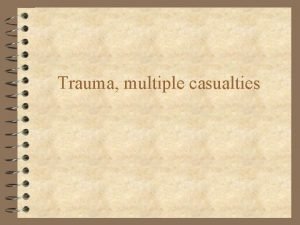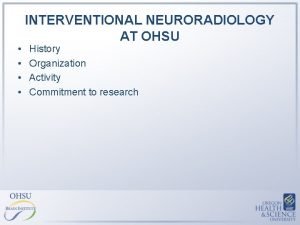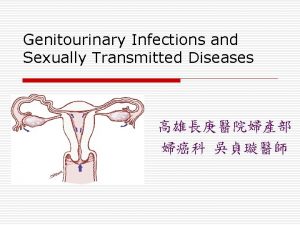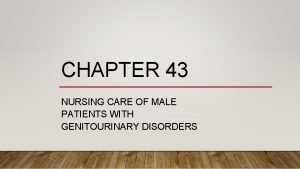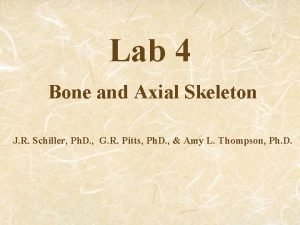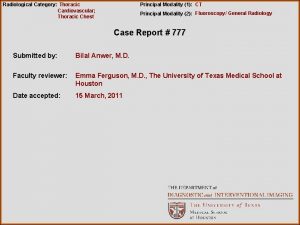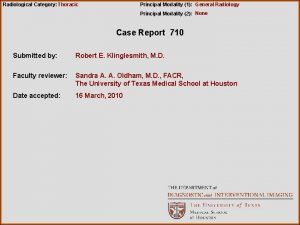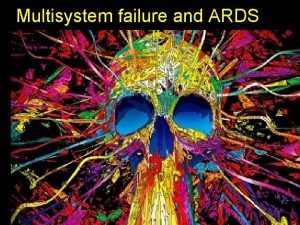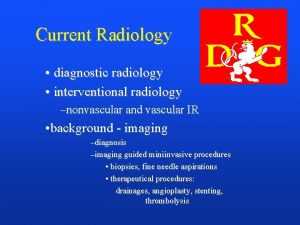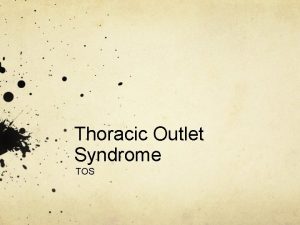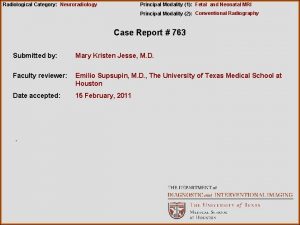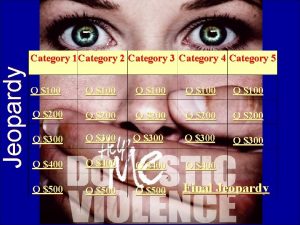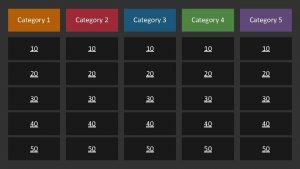Radiological Category Multisystem Neuroradiology Thoracic radiology Genitourinary and
















- Slides: 16

Radiological Category: Multisystem ( Neuroradiology, Thoracic radiology, Genitourinary and Musculoskeletal radiology) Principal Modality (1): CT Principal Modality (2): MR, Plain radiography Case Report # 776 Submitted by: Sireesha Yedururi , M. D. Faculty reviewer: Vinodh A. Kumar, M. D. , The University of Texas Medical School at Houston Date accepted: 8 February, 2011

Case History Multisystem imaging manifestations of a disease entity in three different patients (Patient 1 is a 46 year old female, patient 2 is a 66 year old male and patient 3 is 76 year old male).

Radiological Presentations - Patient 1 Axial non contrast head CT (brain and bone windows)

Radiological Presentations - Patient 1 Axial T 1 pre contrast Axial FLAIR Coronal T 1 post Axial T 1 post contrast

Radiological Presentations - Patient 2 Axial FLAIR Coronal T 1 post contrast

Radiological Presentations - Patient 3 Axial chest CT with contrast

Radiological Presentations - Patient 3 Axial abdomen CT with contrast Coronal reformats of the abdomen CT with contrast

Radiological Presentations - Patient 3 Right humerus AP view Right femur AP views

Test Your Diagnosis Which one of the following is your choice for the appropriate diagnosis? After your selection, go to next page. • Erdheim Chester disease • Lymphoma • Sarcoidosis • Langerhans cell histiocytosis

Findings: Findings and Differentials Patient 1: Non contrast head CT: Multiple, hypodense, extra-axial, dural based masses along the falx are seen with central stellate hyperdense areas. Images through the orbit demonstrate bilateral, irregular, hyperdense infiltrative masses involving the intracontal and to a lesser extent extracontal compartments. Bone windows reveal ill defined sclerosis of the skull base bones and left maxillary alveolar ridge. Brain MRI with contrast: Multiple large dural-based supra-tentorial enhancing masses with local mass effect are present. The central stellate area enhances less avidly compared to the remaining mass. Bilateral orbital infiltrative masses are present with intraconal and to a lesser extent extraconal component that enhance avidly. Patient 2: Brain MRI with contrast: Abnormally increased T 2/FLAIR signal with patchy irregular enhancement is seen in the cerebellum, brain stem and cerebellar peduncles.

Findings: Findings and Differentials Patient 3: Chest CT with contrast: Ill defined infiltrative mass involving the right atrial pericardium and myocardium and the adjacent mediastinal fat is noted. Infiltrative process is also seen around the coronary arteries and coronary sinus. Mild circumferential aortic wall thickening is also present. Minimal pleural thickening is seen bilaterally. CT Abdomen and Pelvis with contrast: Diffuse infiltrative mass in bilateral perirenal spaces is noted extending into renal hila. Both adrenal glands are involved by this diffuse infiltrative process. Circumferential aortic wall thickening is also present, extending to involve the celiac artery, SMA, renal arteries and bilateral common iliac arteries. AP view of the right humerus, right hip and distal femur: Irregular ill defined patchy sclerosis is seen in the diaphysis and metaphsis associated with irregular cortical thickening. This bone involvement is also seen on the contralateral side (not shown) Differentials: • Erdheim Chester disease • Lymphoma • Sarcoidosis • Langerhans Cell Histiocytosis • Idiopathic retroperitoneal fibrosis

Discussion Erdheim-Chester disease (ECD) is a rare, progressive xanthogranulomatous infiltrative disease of unknown etiology, characterized by deposition of lipid-laden histiocytes in various organs. Histopathologically, the infiltrates show lipid-laden histiocytes, immunopositive for CD 68 and immunonegative for S-100, CD 1 a and Birbeck granules. The disease shows slight predilection for men, and has a peak incidence between the fifth and sixth decade of life, although it may manifest at any age. The 5 -year survival rate of 41%. Skeletal involvement is most common in the long bones of the lower limbs. Extra-skeletal manifestations are present in about 50% of the patients. The most commonly involved sites are the retroperitoneum (specifically perirenal regions), lungs, the central nervous system (brain stem and cerebellum), orbits and skin. The clinical course of ECD ranges from the absence of symptoms to a very poor outcome.

Discussion The reported imaging findings in the CNS include T 2 signal abnormalities with patchy enhancement in brain stem and cerebellum and multiple dural based masses. Enhancement or abnormal signal intensity of the pituitary gland has been reported in rare instances. Similarly, the findings in the orbit include intraconal/extraconal infiltrative masses resulting in proptosis/exophthalmos. The imaging findings in chest include infiltrative mass involving the mediastinal fat, right atrial wall and pericardium, circumferential thickening of the aorta and the major branch vessels, diffuse reticulonodular thickening in the lung parenchyma and pleural thickening. The imaging findings in the abdomen include retroperitoneal infiltrative mass particularly in the perinephric region and circumferential thickening of the aorta extending into the iliac arteries. The typical findings in the long bones include diffuse or patchy opacities, medullary sclerosis and cortical thickening of the metaphysis and diaphysis without epiphyseal changes.

Discussion Bony lesions in Langerhans cell histiocytosis (LCH) typically involve the skull, spine and long bones and are typically lytic in nature. Otomastoiditis is seen with LCH but extra-axial masses and a brainstem infiltrative mass does not favor the diagnosis. Diffuse infiltrative process in the mediastinum and perirenal fat are not typical of LCH. Lymphoma and sarcoidosis can present as patchy infiltrative process in the brain stem. Extra-axial masses are unusual. Leptomeningeal enhancement is typically seen with these two conditions. Orbital infiltrative process can occur with these two conditions as well as mediastinal and retroperitoneal infiltrative process. However, the typical distribution in the perinephric fat and circumferentially around the aorta favors Erdheim-Chester disease. Idiopathic retroperitoneal fibrosis typically spares the posterior region of the aorta and is not associated with bone lesions.

Diagnosis Erdheim Chester disease

References De Filippo M, Ingegnoli A, Carloni A, Verardo E, Sverzellati N, Onniboni M, Corsi A, Tomassetti S, Mazzei M, Volterrani L, Poletti V, Zompatori M. Erdheim-Chester disease: clinical and radiological findings. Radiol Med. 2009 Dec; 114(8): 1319 -29. Epub 2009 Nov 14. Wright RA, Hermann RC, Parisi JE. Neurological manifestations of Erdheim-Chester disease. J Neurol Neurosurg Psychiatry. 1999 Jan; 66(1): 72 -5. Drier A, Haroche J, Savatovsky J, Godeneche G, Dormont D, hiras J, Amoura Z, Bonneville F. Cerebral, facial, and orbital involvement in Erdheim-Chester disease: CT and MR imaging findings. Radiology. 2010 May; 255(2): 586 -94. Brun AL, Touitou-Gottenberg D, Haroche J, Toledano D, Cluzel P, Beigelman-Aubry C, Piette JC, Amoura Z, Grenier PA. Erdheim-Chester disease: CT findings of thoracic involvement. Eur Radiol. 2010 Nov; 20(11): 2579 -87. Epub 2010 Jun 20.
 What is the definition of multisystem trauma?
What is the definition of multisystem trauma? Ohsu neuroradiology
Ohsu neuroradiology Center for devices and radiological health
Center for devices and radiological health E-rate category 1 vs category 2
E-rate category 1 vs category 2 National radiological emergency preparedness conference
National radiological emergency preparedness conference Radiological dispersal device
Radiological dispersal device Tennessee division of radiological health
Tennessee division of radiological health Chapter 29 the child with a genitourinary condition
Chapter 29 the child with a genitourinary condition Chapter 29 the child with a genitourinary condition
Chapter 29 the child with a genitourinary condition Genitourinary & stds
Genitourinary & stds Male genitourinary anatomy
Male genitourinary anatomy Nursing care of male patients with genitourinary disorders
Nursing care of male patients with genitourinary disorders Lungs body cavity
Lungs body cavity Mental anatomical term
Mental anatomical term Ventral cavity
Ventral cavity Lumbar vertebrae characteristics
Lumbar vertebrae characteristics Venipuncture radiologic technologist
Venipuncture radiologic technologist
